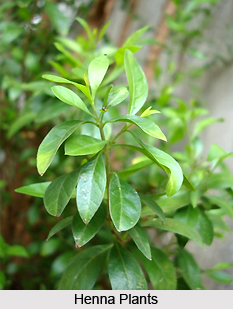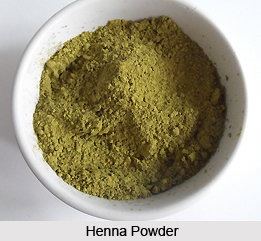 Henna is a medium-sized shrub with numerous branches. It has small white or pinkish perfumed flowers in large terminal bunches, and small spherical fruits. The trade name henna is based on the word `hina`, the Arabic name of the drug.
Henna is a medium-sized shrub with numerous branches. It has small white or pinkish perfumed flowers in large terminal bunches, and small spherical fruits. The trade name henna is based on the word `hina`, the Arabic name of the drug.
The plant grows in various parts of India, principally in the drier parts of the peninsula, and is generally cultivated in hedges. It is also cultivated for mercantile purposes, in Punjab, Gujarat, Madhya Pradesh and Rajasthan.
The leaves contain a glucoside colouring matter and hennotanic acid. On petroleum ether extraction, the seeds of the plant produce glutinous oil containing behenic, arachidic, stearic, palmitic, oleic and linoleic acids.
Methods of usage
Henna is exceedingly beneficial for a number of disorders, like hairfall, dysentery, liver, headaches, stinging feet, skin infection and female diseases.
Healing Power and Medicinal Properties of henna
The leaves have curative properties, like checking secretion or blood loss and forestalling skin disorders. The bark and seeds of the plant are used in Ayurvedic and Unani medicine.
Dysentery cured by henna
The seeds of henna plant are effectual in the curing of dysentery. They are fine-grained, blended with ghee and composed into tiny balls of the size of a betel nut. It is also very helpful in this condition, when consumed with water.
Liver Disorders healed by henna
The bark of the plant is effective in the healing of liver troubles like jaundice and expansion of the liver. Its powder is used both in 1.25 to 5 decigram dosages, or its decoction in 30 to 60 gram dosages in treating these disorders.
Baldness checked by henna
Henna helps in the arresting of baldness. Mustard oil boiled with henna leaves, boosts vigorous growth of hair. Two hundred and fifty grams of mustard oil is boiled in a tin basin. Sixty grams of the leaves are slowly added to the oil and heated. The oil is then sieved through a cloth and preserved in a bottle. Everyday massage with this oil furnishes abundant hair.
 Prickly Heat healed by henna
Prickly Heat healed by henna
Henna leaves are advantageous in the treatment of heat rash. The leaves powered with water are massaged over the affected portion.
Headaches cured by henna
Henna flower mends headaches caused by the scorching heat of the sun. Headache is alleviated by a poultice made of henna flowers in vinegar and administered on the forehead.
Burning Sensation on the Feet remedied by henna
A paste of the leaves applied on the soles eases the stinging sensation of the feet.
Skin Diseases cured by henna
Henna leaves are effective in the treatment of skin disorders, like boils and burns. They are locally administered in the affected area. Bruised leaves can be applied constructively in rheumatic joints, inflammatory swellings, wounds and leprosy.
Sore Throat cured by henna
A decoction of the leaves can be used as gargle, with favourable consequences, in case of throat pain.
Women`s Ailments healed by henna
Pessaries or vaginal suppositories made from the leaves and seeds can be used constructively in treating unnecessary menstruation, vaginal discharges and leucorrhoea, or excessive white discharge.
Other Uses of henna
Spermatorrhoea or Involuntary Ejaculation - The juice of fresh leaves is advantageous, in condition that it is given in dosages of 8 to 16 grams.
Henna is mainly used as a colouring agent. It is mixed with other natural dyes and is extensively used as hair dye and even for textiles. The oil obtained from its flowers is used in perfumery.











